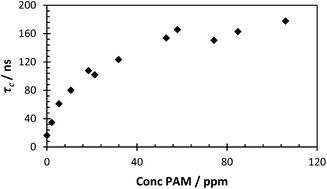Poly(acrylic acid) interpolymer complexation: use of a fluorescence time resolved anisotropy as a poly(acrylamide) probe†
Abstract
A low concentration poly(acrylamide) sensor has been developed which uses the segmental mobility of another polymer probe with a covalently attached fluorescent marker. Interpolymer complexation with poly(acrylic acid) leads to reduced segmental mobility which can be used to determine the concentration of polymer in solution. This technique could be useful in detecting the runoff of polymer dispersants and flocculants in fresh water supplies following water purification processes.


 Please wait while we load your content...
Please wait while we load your content...